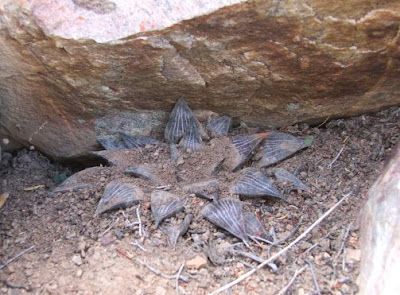Haworthia marxii is probably one of the most interesting recent discoveries of Haworthia.
The plants were documented by J.D. Venter several years ago, as Haworthia bayeri "Rooinek Pass". The latter refers to a mountain pass south-east of Laingsburg. This given locality for Haworthia bayeri has always seemed questionable as:
1. Rooinek Pass is north of the Swartberg in the western Great Karoo, a vast arid expanse where no retuse Haworthia has ever been recorded.
2. The most westerly known distribution of Haworthia bayeri is in the Oudtshoorn district, which lies south of the Swartberg in the Little Karoo. This leaves a gap of some 140 km between the Rooinek Pass Haworthia and the nearest known Haworthia bayeri and more than 70 km from any other retuse Haworthia ( which is a form of Haworthia maraisii from near Barrydale).
Gerhard Marx and Martin Scott were the first to re-explore the area and when the plants were eventually found it quickly became clear that the plant J.D. Venter referred to is actually a new species, the only retuse Haworthia known from the western Great Karoo, and many kilometers removed from any other retuse Haworthia !
The rather attractive plants were then described by Sean Gildenhuys as Haworthia marxii ( ALOE 44:1: 2007, p. 4 -8).
At first glance, especially during times of drought, Haworthia marxii does have some resemblance to Haworthia bayeri.
In habitat both species have the "muddy" appearance of the leaf epidermis. This is where the similarity ends however. The following differences between the two species are noteworthy:
While H bayeri normally contracts with its leaves deep into the soil, Haworthia marxii is a shallow growing plant. H bayeri has thick fleshy roots similar to H truncata, whereas Haworthia marxii has thin roots. Haworthia marxii has white little dots in the leaf windows similar to Haworthia picta. This feature is absent in Haworthia bayeri. The leaves of Haworthia marxii are also flatter with the tips ending in a sharper point.
Furthermore, the flowering peduncles of Haworthia marxii are very thin compared to the thicker ones of Haworthia bayeri. The flowering period, February, is also considerably later than that of Haworthia bayeri and one rather unusual aspect of Haworthia marxii is that the plants grow in rock crevices on steep sandstone mountain slopes at an altitude of about 1000 meters. Haworthia bayeri occurs on lower hillsides amongst ferricrete pebbles.
There is little doubt that Haworthia marxii is a good species. It is also a very important discovery as it now opens the door for possible other retuse Haworthias to be discovered in the Great Karoo !
Haworthia marxii proved to be difficult in cultivation and is very slow growing from seed.
 Haworthia marxii in habitat growing amongst sandstone. The plants do not withdraw into the soil.
Haworthia marxii in habitat growing amongst sandstone. The plants do not withdraw into the soil. Haworthia marxii, a slight resemblance to Haworthia bayeri.
Haworthia marxii, a slight resemblance to Haworthia bayeri. Haworthia marxii amongst lichens at high altitude.
Haworthia marxii amongst lichens at high altitude. Haworthia marxii. Lanceolate leaf showing white dots.
Haworthia marxii. Lanceolate leaf showing white dots. Haworthia marxii flower on thin peduncle.
Haworthia marxii flower on thin peduncle.Notice: 19 February 2012: A recent revision by Bruce M Bayer, regarding Haworthia marxii as synonymous with Haworthia emelyae (picta) is very surprising as the plants do not occur in the geographic area of Haworthia emelyae (sensu Bayer) and are obviously very different. This raises questions about objectivity and proper analysis.
Notice: 11 July 2012: Recently Mr. Bayer has accepted Haworthia marxii as a good species. The reasons for its initial inclusion under Haworthia emelyae (picta) will not be mentioned here.